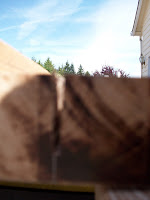If you recall, the tile has been removed from the island and we have one slab of butcher block that runs the length of the island, 74"X25" and now we need to cut two pieces 37"X12.5" to cover the remaining portion of the island. Now you might ask yourself, why two pieces, well we have a piece left over from counters we did back in Colorado and if it is cut to length and then ripped exactly in half it leaves us with the coverage we need.
There is now only isle and no tile, whew!


So after some attempts to use our table saw to rip the butcher block it was determined that the table was not wide enough so we have to create our own jig and use the circular saw.


Fortunately there was some lumber left here that was straight enough to use as a guide. Note to first time jig makers: take care to plan which side of the saw you will be guiding against where "waste" and physical attributes of the saw are concerned. e.g. you might set you jig to guide on the left edge of the saw, but find that since the motor is there you can not actually operate the motion of the cut. As our circular saw has its "waste" cut to the right much care had to be taken to ensure that the offset was correct when guiding from the right side.
Now if you have never cut 1 1/2 thick hardwood before, maple in our case here, you probably can not just zip through the entire thickness without stalling the saw or worse - if you can you have MUCH better tools than we.
So the strategy used is to cut 1/4" depths until completely through the wood:
{1/4", 1/2", 3/4", 1", 1-1/4", 1-1/2"} now I must confess that normally after getting to 1" making the jump to the full depth seems to work, I discovered this the first time out of error.



Here are some close ups of the channel being cut and the jig/saw horse setup also...

The big cuts are made so we took the pieces into the kitchen to do a fit check...



Now below you can see the the ends must be cut to length and the same process as before was followed. Right side jig and ~10 cuts later both pieces are the length we need.



Next a handheld jigsaw was employed to round off the outer corners.


And then some extra plywood was used to create a little shade
and it worked great until the Wind came along...
And now something completely different...
Barely visible is our newest tool, the router, a 3/8" roundover bit is being used and all of the external top lips of the counter, whenever possible a jig was used to eliminate depth error.



And another dry fit after routing is complete.
 Still some finish work to complete and attaching the counter, to be concluded...
Still some finish work to complete and attaching the counter, to be concluded...and next up is the aforementioned dining room

 look at those angles...
look at those angles...
No comments:
Post a Comment